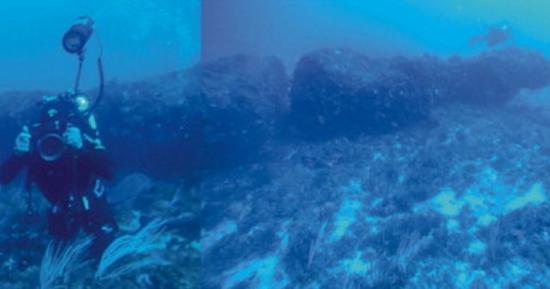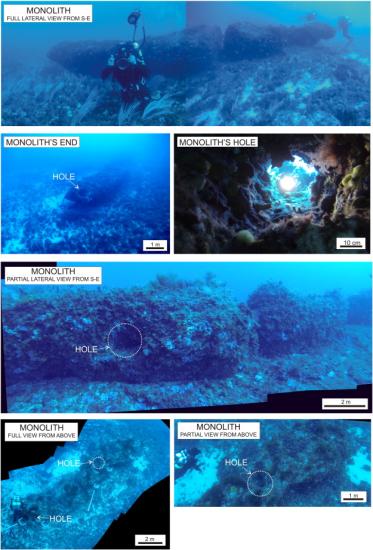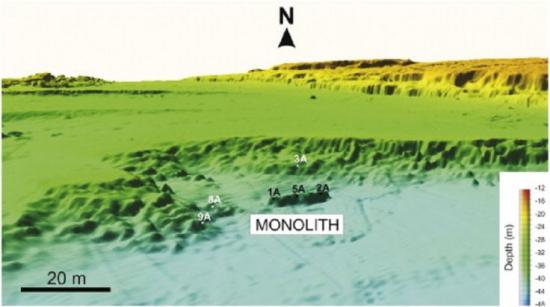Sean Martin
Source - http://www.ibtimes.co.uk/underwater-stonehenge-huge-monument-made-by-ancient-civilisation-discovered-off-coast-sicily-1514255?
 Submerged monolith in the Sicilian Channel(Lodolo et al/Journal of Archaeological Science: Reports)
Submerged monolith in the Sicilian Channel(Lodolo et al/Journal of Archaeological Science: Reports)
Archaeologists have discovered what they believe is the remains of a massive man-made monument built by an ancient civilisation that serves a similar, mysterious, purpose to Stonehenge.
A report published in Science Direct details how a 12-metre-long man-made monolith was discovered in the deep sea off the coast of Sicily in what was once an island called the Pantelleria Vecchia Bank.
 Underwater composite photographs taken from divers, showing the discovered monolith and some details.(Lodolo et al/Journal of Archaeological Science: Reports)
Underwater composite photographs taken from divers, showing the discovered monolith and some details.(Lodolo et al/Journal of Archaeological Science: Reports)
They believe that the monument, which was split in half, came from an ancient civilisation from more than 10,000 years ago, but was eventually submerged during a massive flood.
The statue has three holes in it with one going right through the middle in what is described as a "unique and significant structure", say authors Zvi Ben-Avraham from the Department of Earth Sciences at Tel Aviv University, and Emanuele Lodolo, from the Istituto Nazionale di Oceanografia e di Geofisica Sperimentale (OGS) in Trieste, Italy.
They write: "The discovery of the submerged site in the Sicilian Channel may significantly expand our knowledge of the earliest civilisations in the Mediterranean basin and our views on technological innovation and development achieved by the Mesolithic inhabitants.
 3-D perspective view of the high-resolution bathymetric map where the monolith has been discovered(Lodolo et al/Journal of Archaeological Science: Reports)
3-D perspective view of the high-resolution bathymetric map where the monolith has been discovered(Lodolo et al/Journal of Archaeological Science: Reports)
"The monolith found, made of a single, large block, required a cutting, extraction, transportation and installation, which undoubtedly reveals important technical skills and great engineering. The belief that our ancestors lacked the knowledge, skill and technology to exploit marine resources or make sea crossings, must be progressively abandoned.
"The recent findings of submerged archaeology have definitively removed the idea of 'technological primitivism' often attributed to hunter-gatherers coastal settlers."
They added the find shows how little we still know of early civilisations: "The idea that early human ancestors once lived at the sea-floor of modern seas easily fascinates and attracts our imagination.
"What is more surprising, and until recently poorly recognised, is that an extensive archaeological record of early settlements still remains on the sea-floor of our continental shelves ... The vast majority of marine geophysicist and archaeologists have now realised that to trace the origins of civilisation in the Mediterranean region, it is necessary to focus research in the now submerged shelf areas."
A submerged monolith in the Sicilian Channel (central Mediterranean Sea): Evidence for Mesolithic human activity
Emanuele Lodolo, Zvi Ben-Avraham
Journal of Archaeological Science: Reports Volume 3, September 2015, Pages 398–407
Abstract
The ancient geography of the Mediterranean Basin was profoundly changed by the increase in sea level following the Last Glacial Maximum. This global event has led to the retreat of the coastlines, especially in lowland areas and shallow shelves, such as the Sicilian Channel. The NW sector of this shelf, known as Adventure Plateau, is studded by isolated shoals mostly composed of Late Miocene carbonate rocks and by some volcanic edifices. These shoals, until at least the Early Holocene, formed an archipelago of several islands separated by stretches of extremely shallow sea. One of these submerged features – the Pantelleria Vecchia Bank – located 60 km south of Sicily, has been extensively surveyed using geophysical and geological methods. It is composed of two main shoals, connected seaward by a rectilinear ridge which encloses an embayment. Here we present morphological evidence, underwater observations, and results of petrographic analysis of a man-made, 12 m long monolith resting on the sea-floor of the embayment at a water depth of 40 m. It is broken into two parts, and has three regular holes: one at its end which passes through from part to part, the others in two of its sides. The monolith is composed of calcirudites of Late Pleistocene age, as determined from radiocarbon measurements conducted on several shell fragments extracted from the rock samples. The same age and composition characterize the metre-size blocks forming the rectilinear ridge. The rest of the rocks composing the shoals are mostly Tortonian limestones–sandstones, as revealed by their fossil content. Extrapolating ages from the local sea level curve, we infer that seawater inundated the inner lands at 9350 ± 200 year B.P., the upper limit which can be reasonably taken for the site abandonment. This discovery provides evidence for a significant Mesolithic human activity in the Sicilian Channel region.